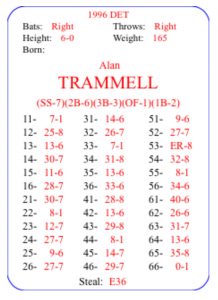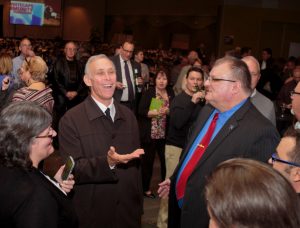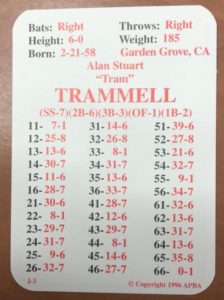Of the thirty-three Hall of Famers I’ve had the privilege to see play in person, I saw Alan Trammell play the most. When I think of Alan Trammell, three things immediately pop into my mind: class, consistency, and professionalism. From 1977-1995 with Lou Whitaker, Alan Trammell was part of the greatest double play combination in baseball history. In two weeks, Trammell will finally be inducted into the Baseball Hall of Fame. His double play partner should be joining him, but that’s another story.
Trammell played his entire 20 year career in Detroit. Alan finished with a career average of .285, with 2,365 hits. He hit .300 or better in seven different seasons. When he retired in 1996, his six seasons hitting at least .300 with 10 home runs were tied with fellow Hall of Famer Joe Cronin for the most among shortstops in big league history. It’s hard to remember, but when Trammell came to the Big Leagues in 1977, shortstops weren’t expected to produce offensively. Even playing in the shadow of Cal Ripken, Jr. and Robin Yount, Trammell won four Gold Glove Awards, three Silver Slugger Awards and six All-Star Game selections.
It’s been a long road to the Hall of Fame for Trammell. Statistically, Trammell was the 11th best shortstop in history, but there were several factors that kept him off the national radar. First, he played in Detroit…not New York, Los Angeles, or Chicago. If Trammell had played for the Yankees, he would have been in the Hall within his first three years of eligibility. Second, he played in the same era as Cal Ripken, Jr., Robin Yount, and Ozzie Smith. Trammell’s consistency was often overshadowed by these fellow Hall of Famers. Third, he only played in the playoffs twice, winning the World Series Championship in 1984. Fourth, he never won an MVP award (though he should have in 1987). Trammell’s 1987 monster season was one of the best ever for a shortstop. Fifth, he played in an era when only a handful of games were on local television…and even fewer were nationally broadcasted. Let’s just say that Trammell wasn’t on the Game of the Week as often as Ozzie Smith or Cal Ripken, Jr. Finally, he first appeared on the Hall of Fame ballot in the midst of the steroid era, when shortstops like Alex Rodriguez and Miguel Tejada were using PEDs, putting up huge numbers, and winning MVPs.
| Split | G | GS | PA | AB | R | H | 2B | 3B | HR | RBI | SB | CS | BB | SO | BA | OBP | SLG | OPS | GDP | SH | SF |
|---|---|---|---|---|---|---|---|---|---|---|---|---|---|---|---|---|---|---|---|---|---|
| 1996 Totals | 66 | 50 | 207 | 193 | 16 | 45 | 2 | 0 | 1 | 16 | 6 | 0 | 10 | 27 | .233 | .267 | .259 | .526 | 3 | 1 | 3 |
Alan Trammell’s final APBA card is as disappointing as it taking 17 years for him to be elected to the Hall. Trammell hit a disappointing .233 in his final campaign. Yet, APBA issued him a card that will only hit .206. I’m mystified as to why this card doesn’t have a 33-7. If it did, it’d produce a .235 average. Here’s what his card should look like:
By his final season, the 38-year old Trammell was an injury-prone utility man for a dismal Detroit team that finished 53-109. This was common during the last five years of his career, where Trammell only played in 100+ games once. However, the Trammell I remember from my youth was a clutch hitter, rock-solid defender, and team leader. Sure, I recall watching his glorious World Series MVP moments on television, but there’s one moment that sticks in my mind. It was a random game in the mid-1980s in the middle of the summer. I was sitting in the centerfield bleachers at Tiger Stadium and Trammell came to bat and hit a routine fly ball to shallow centerfield. If I had done the same thing, I might have tossed my bat down in disgust and jogged to first. Most Big League players would do that. But, that’s not what Alan Trammell did. No, he was sprinting (like you’re taught when you first start playing). Sure enough, the ball was muffed and the hustling Trammell ended up on second base. Looking at the box score of the games I attended, I saw Trammell get many hits, even some homers. However, I don’t remember those. No, I remember him hustling to second for a two-base error. That’s Alan Trammell to me. That’s the kind of player he was.
I’ve been lucky to briefly meet a few Baseball Hall of Fame players: Warren Spahn, Willie Stargell, Jack Morris, Goose Gossage, Luis Aparicio, and Ozzie Smith. Three years ago, I had the pleasure of shaking hands with Tram and talking to him for a couple of minutes. This encounter happened at the West Michigan Whitecaps Winter Banquet. The Whitecaps are a class A affiliate of the Detroit Tigers and every winter current and former players visit the Grand Rapids, MI area. After my meeting with Trammell, a rather embarrassing photo was taken which ended up in the local newspaper.  In the photo, I’m watching Trammell as I get ready to take another swig of my beer. My brother saw it the next morning online and, in a series of texts, made sure to let me know how ridiculous he thought I looked. Looking at the photo, I don’t blame him. I could feel him laughing, crying, and falling on the floor through my iPhone. Nonetheless, Tram was great. He stood in that same area for about an hour and was extremely kind to the fans and media. His humbleness was impressive.
In the photo, I’m watching Trammell as I get ready to take another swig of my beer. My brother saw it the next morning online and, in a series of texts, made sure to let me know how ridiculous he thought I looked. Looking at the photo, I don’t blame him. I could feel him laughing, crying, and falling on the floor through my iPhone. Nonetheless, Tram was great. He stood in that same area for about an hour and was extremely kind to the fans and media. His humbleness was impressive.
The last weekend of this month is induction weekend. I will be attending in celebration of Alan Trammell’s (and Jack Morris’s) induction into the Baseball Hall of Fame. I look forward to seeing him ride by in the Parade of Legends. I’m curious what he’ll say in his induction speech. I’m excited to see his plaque and buy the postcard to hang on my classroom wall with the other Detroit Tigers Hall of Famers. Mostly, I’m eternally pleased that my childhood team, the 1984 Detroit Tigers, will finally be represented in Cooperstown.





Hi Kevin,
I am betting that if you purchase the reissued set it will have the 7. They have made many result/pitching grade changes over the last few seasons. Not able to confirm, but just my observation.
Great write up on Trammell. He is certainly worthy of the Hall.
The media must HATE Lou Whitaker. Look up Bill Mazeroski and Lou Whitaker in the baseball encyclopedia and tell me who’s a hall of famer.